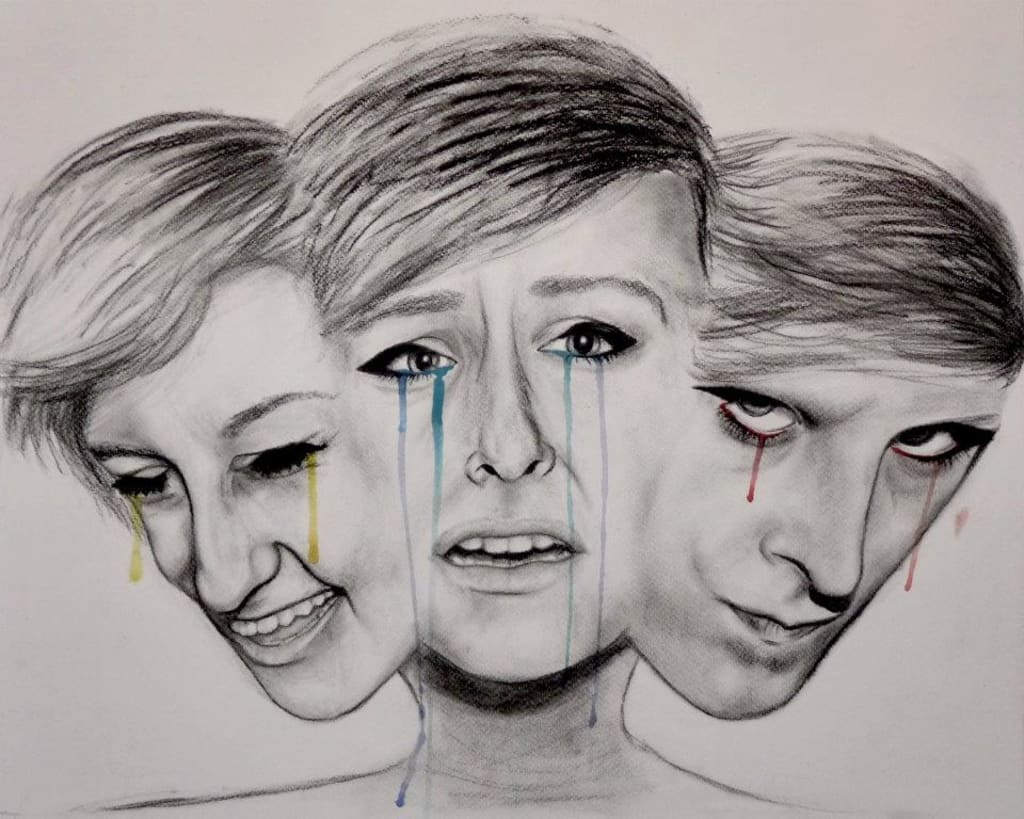Psychology: Dissociative Disorders
By: Nathaniel Reidhead

There is a significant controversy regarding mental disorders in our society regarding frequent confusion of classifications, but not only is this a common problem among countries everywhere, the real issue that remains critically problematic today is the strenuous evaluation salient for accurate diagnosis and speculation for the mentally disturbed. Currently, the contemporary statistical analysis of the disorders that plague us is unequivocally compromising our psychological health and is detrimental to how we behave and think. In 2009, an estimated 1 percent of the world population suffered from schizophrenia; in the United States alone, 3.2 million individuals were professionally diagnosed with schizophrenia, which is a considerable amount regarding the rarity of this infliction. According to the fifth and current edition of the Diagnostic and Statistical Manual of Mental Disorders (DSM-5), 1.5 percent of the American adult population alone suffers from Dissociative Identity Disorder as of 2013 (also the publication year of the DSM-5), although some doctors will estimate averages as high as 3-5 percent.
Focusing specifically on dissociative disorders, the complexities can be identified as being indicative of heightened activity in cerebral areas associated with control and inhibition of traumatic memories typically triggered by physical and sexual abuse and possibly neglect resulting in abandonment issues. What is extremely difficult in identifying these disorders is subjugating patients with credible evaluation techniques to properly identify and diagnose them while differentiating between legitimate cases and behaviour that is strictly illegitimate role-playing, which, in these cases, might be an indication of histrionic personality disorder (HPD). Regarding role-playing in the sense of general behaviour in which dissociative disorders are primarily symptomatic, these cases are complex illnesses and identifying them with careful precision demands attentive and accurate evaluation.
Overall, it has been estimated that approximately 2 percent of the United States population alone suffers from a variety of dissociative disorders. Often, regarding cases professionally diagnosed and reported, women tend to be much more susceptible than men. Of course, this includes mainly adults as it is difficult to identify children and those beginning their adolescent stage in mental and physical development. Theoretically, it is suggested that children are even more susceptible to these illnesses.
Multi-Personality Disorder (DID)
Commonly known as “Multi-Personality Disorder” or DID (Dissociative Identity Disorder), cases are rare, but all the more prevalent. Symptoms include the identification of two or more separate personalities, loss of memory and previous actions, and loss of time orientation. 95 percent of cases suggest diagnosable posttraumatic stress from a history of physical and/or sexual abuse. Often, children are suspected and ambiguously suggested to have a potential form of it, but those who do tend to not receive the medical attention and diagnosis till adolescence and even adulthood. Treatment is especially difficult; common methods include EMDR (eye movement desensitization and reprocessing), psychotherapy for depression, and on a scarce occasion, hypnosis. Those who have DID are more likely to engage in unhealthy alcoholic consumption and persistent drug use as well as suffer emotionally, in which case medication can be used for mood stabilizing, although it is used with caution due to the risk of reinstituting traumatization.
There was a case in the 1950s of a woman name Christine “Chris” Costner Sizemore who was diagnosed with MPD who was speculated to have three personalities known as “Eve White,” “Eve Black,” and “Jane.” Her story was written in books, the most famous of all being The Three Faces of Eve by psychiatrist Corbett H. Thigpen and Hervey M. Cleckley, which was made into a film. What was particularly interesting about her case is that her personalities showed in a series of patterns. For instance, if you were speaking with “Eve Black,” you had to ask to speak with “Eve White” before speaking with “Jane.” She eventually died in hospice care because of a heart attack on July 24, 2016. She was a respected advocate for mental health.
Dissociative Fugue Disorder
The implications of dissociative fugue suggest it is not only rare but sometimes considered unreal. There have been few factual documented cases of DFD. Someone with dissociative fugue disorder experiences a loss or confusion of their personal identity and begins to form a new one. Cases typically begin with unexplained travel. Commonly known as dissociative amnesia, the mental illness has three states in which memory loss is the prime detriment to personal identity: localized, generalized, and fugue state. Localized memory loss affects specific areas of knowledge or parts of a person’s life, like a friend or coworker. Often, the illness focuses on a specific trauma. For instance, if a person with localized memory loss can forget about the events of being violently beaten and raped, but can recall the events of the day before and after the traumatic event. Someone who experiences a general loss of memory loses major recollection of their life that can include but is not limited to your name, your job, your friends, and your family. With a person concerning dissociative fugue, they suffer from generalized memory loss, but they also adopt a new identity.
There is no subjective way of physically diagnosing fugue disorder, or rather, any dissociative disorder; however, people who suffer will generally be given a physical examination with bloodwork and a CAT scan before being submitted into a psychiatric hospital to be evaluated. Treatments can include EMDR, hypnotherapy, family treatment, cognitive-behavioural therapy, and much more.
Schizophrenia
Commonly confused with Dissociative Identity Disorder (DID or MPD), schizophrenic people tend to experience delusions and hallucinations, have incoherent speech, grossly disorganized behaviour like laughing at the death of a friend, as well as having the inability to show emotion and exhibiting catatonic behaviour. Typically, they have reduced speech and a lack of motivation. As previously mentioned, 1 percent of the world suffers from schizophrenia. With 3.2 million people diagnosed with schizophrenia, there is an excellent possibility that just about anyone could have encountered one. What is extremely common is the misconception that schizophrenic people hear voices, which turns out not to be the case. Their incoherent speech is just a manifestation of an affixation of tangent thoughts and jumbled speech. The main reason people confuse schizophrenia and MPD is because of “talking to people who are not there,” which isn’t the case for either because someone with MPD cannot experience coexisting personalities at the same time; it is cognitively precluded. This means that any speech referring to another personality isn’t the evidence of speaking to another entity that isn’t present, but another personality that exists in the mind of both the sufferer of MPD and the surrounding individuals, because we can witness a change of behaviour. Talking to oneself is considered cognitively and socially normal, although people who are schizophrenic will talk to not themselves, but people or things that are not there if they experience delusions and hallucinations. The major treatment that exists currently to treat schizophrenia is called antipsychotics. Everyone reacts a little differently to the medication, so a person may go through several medication changes before receiving the one that works the best.
Dissociative Disorders: Awareness
As a people, we need to be aware of the implications that mental illness presents. More than anything, we need to be supportive and know that these things exist. There are so many negative connotations related to these inflictions. When a person is suffering, close socialization is needed to provide comfort and stabilization so that said inflicted individuals get the medical attention that they so desperately need. This is not something that can be overlooked; instead, attentiveness and self-awareness of mental health are crucial in leading as much of a normal life as possible.
Call a Crisis Call Center at this number if you or someone you know may need medical assessment and close evaluation: 800-273-8255.
Works Cited:
National Alliance on Mental Illnesses (NAMI) “Dissociative Disorders” 2016
Professor Holly Hacket, PhD. “General Psychology: Dissociative Disorders” December 2016 Missouri Southern State University
The Cleveland Clinic Foundation “Dissociative Amnesia” Published 5/20/16
About the Creator
Nathaniel Reidhead
Hey everyone, call me Nathan. I am a student at MSSU and I am a psychology major. I love to write stories and poetry and even essays.
Enjoyed the story? Support the Creator.
Subscribe for free to receive all their stories in your feed. You could also pledge your support or give them a one-off tip, letting them know you appreciate their work.






Comments
There are no comments for this story
Be the first to respond and start the conversation.